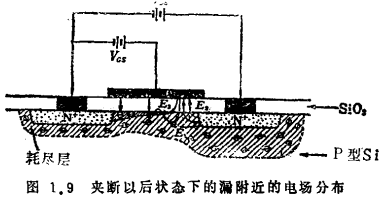Electronic Technology Forum
Analysis of working state of MOS field effect transistor after pinch-off
As explained in the previous section, the limit of the theoretical formula for the area after pinch-off is: the leakage conductance at the pinch-off point is zero. If the leakage voltage is further increased to reach the region after the pinch-off, the above theoretical formula is still used mechanically, the result of the leakage conductance will be negative, but in fact, although the current saturation phenomenon continues, the leakage conductance is not negative. value. If the theoretical formula of the area before pinch-off is extended to the area after pinch-off, wrong results will be obtained. The reason is that on the drain side after pinch-off, for example, in the case of the N-channel, if only electrons are considered, the induced electron density becomes a negative value.
The induced carrier density is negative, which is impossible from the point of view of physics, and formula (1.10) is a relational formula of electrostatics, of course it is true in itself. The MOS tube is pinched off. On the drain side of the pinch-off point (that is, the drain region), the sign of the induced charge must be reversed. This is determined by the formula (1.10), so a positive charge will appear at the interface between the silicon and the silicon dioxide film. Considering that the substrate is P-type, this positive charge is nothing more than holes. Therefore, the electrons in the channel should also be pushed into the silicon body from the interface between the silicon and the silicon dioxide film, and the electron flow situation shown in Figure 1.8 appears. . The electrons take this distribution 4) can also be obtained from the current equation and the (Bai Song equation simultaneous numerical solution).
Therefore, to analyze the volt-ampere characteristics of the MOS field effect transistor after pinch-off, a two-dimensional model should be used. However, at the point where it happens to be pinched off, the leakage conductance becomes zero. Equation (1.19) can be expressed by equation (1.47). Extrapolating this equation to the region after the pinch off can explain the measured results to a certain extent. The dimensional model can also be analyzed to a certain degree.
Now consider the carrier distribution shown in Figure 1.8. In the drain region, carriers are injected into the space charge layer of the PN junction formed by the drain and the substrate, and drift along the direction of the electric field, so the saturation characteristics of the leakage current after pinch-off are the same as the saturation phenomenon of the contact current of the junction transistor , The leakage voltage is not the main factor that determines the magnitude of the leakage current; and on the source side of the pinch-off point, that is, the source region, the magnitude of the leakage current is determined by the leakage voltage. The MOS tube is pinched off. For junction transistors, the collector voltage changes the thickness of the space charge layer, and the effective base width is modulated, resulting in the so-called Early effect (base modulation effect), that is, the collector of the junction transistor The conductance is determined by the Earley effect. For MOS field effect transistors, the leakage voltage changes the thickness of the space charge layer of the drain junction, thus shortening the effective channel length, increasing the leakage current, and generating positive The leakage conductance value.
If the equation (1.30) is integrated according to this model, if the point just pinched off is x=ls, and integrated from 0 to ls along the x direction, the channel potential VP' of the pinch-off point obtained from equation (1.50) is


Therefore, the formula (1.30) is integrated from 0 to VP' to obtain:

For ls, considering the small leakage current as a first-order approximation, using the depletion layer approximation for the drain junction, the thickness of the space charge layer of the drain junction is L-ls, so it can be written as

If this result is adopted, then

Thus, the leakage conductance obtained is

However, even if the depletion layer approximation can be used, the electric field that determines the thickness of the drain space charge layer is not only determined by the electric field E1 (the electric field E1 is determined by the difference between the leakage potential and the drain potential of the channel). As shown in Figure 1.9, it is also related to the electric field E2 between the drain and the gate and the electric field E3 between the gate and the drain of the channel. The electric field intensity E2 and E3 can be approximately expressed as

Where
V'Gs=V'Gs-фMS+V's, is the equivalent gate voltage
d is the thickness of the silicon dioxide film
ξl and ξs are the dielectric constants of silicon dioxide film and silicon substrate, respectively
a is the fringe field coefficient

as well as

β is fringe field coefficient
As shown in Figure 1.9, the distribution of the electric fields E2 and E3 are complicated for their own reasons. The fringe field coefficients a and β indicate that the leakage to the channel is not one-dimensional. Parameters such as the thickness of the silicon dioxide film and the width of the overlapped part of the gate and drain regions, if not extreme changes with the device, a and β can be considered as constants for the time being. If the value is selected as before, the measured value of leakage conductance can be well explained 5).

As considered in formula (1.63), the electric field intensity E1 generated by impurity ions in the substrate, when the leakage junction is approximated by the abrupt junction, it is assumed to be.

Then the total electric field strength ET in the space charge layer of the leakage junction is

The thickness ld of the space charge layer of the drain junction, if the following formula can be used

Find, then

In the formula, lDB is the thickness of the space charge layer determined by the impurity ion concentration of the substrate, and ldI is the thickness of the space charge layer determined by the gate voltage.
When calculating the output conductance determined by the above-mentioned leakage junction space charge layer expansion effect, because there is

If VDS=V'P, that is, the leakage current at the time of pinch-off is recorded as lDSS, using the relational formula

then

From the formula (1.61)

The resulting output conductance is

Contact: Mr. Zou
Contact number: 0755-83888366-8022
Mobile phone: 18123972950
QQ: 2880195519
Contact Address: 5C1, Block CD, Tianji Building, Tianan Digital City, Chegongmiao, Futian District, Shenzhen
Please search WeChat official account: "KIA Semiconductor" or scan the following picture to "Follow" official WeChat official account
请“关注”官方微信公众号:提供 MOS管 技术帮助



